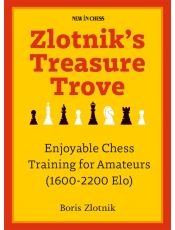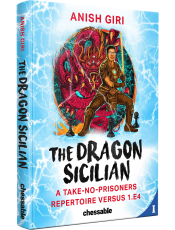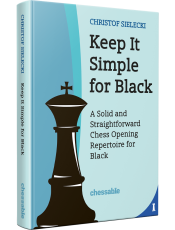
Sadler on Books (2023#3)
These book reviews by Matthew Sadler were published in New In Chess magazine 2023#3
I picked up Zlotnik’s Treasure Trove by the Russian trainer Boris Zlotnik (New In Chess) while looking for puzzles to train my tactics. I haven’t played at all since the first UK Covid lockdown in March 2020, but I still have periodical bouts of panic about my chess strength, which I attempt to soothe by solving puzzles (hopefully successfully!). The title suggested that the puzzles would be entertaining, and indeed, the first five puzzles I solved in Chapter 2 were pleasingly aesthetic. How about this one?
The title suggested that the puzzles would be entertaining, and indeed, the first five puzzles I solved in Chapter 2 were pleasingly aesthetic. How about this one?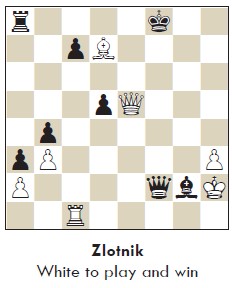 The solution is very neat – I cannot remember seeing this exact tactic before.
The solution is very neat – I cannot remember seeing this exact tactic before.
1.♖c2! ♕xc2 2.♕f6+ ♔g8 3.♗e6+ ♔h7 4.♗f5+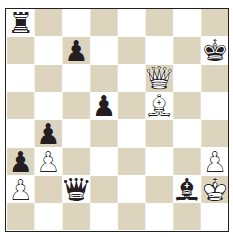 That nice introduction stimulated me to read the rest of the book in the proper order and I was surprised to discover that it wasn’t just a puzzle book but something much broader. This book essentially comprises the musings of an experienced coach (he was a coach of a young Fabiano Caruana) on various aspects of chess, not least the specific challenges that amateurs face (the book starts with a chapter entitled ‘Professionals and Amateurs’ and Zlotnik includes quite a few games by amateur players in the book). Along the way, Zlotnik provides lots of puzzles (including some unusual blindfold ones) to illustrate his ideas.
That nice introduction stimulated me to read the rest of the book in the proper order and I was surprised to discover that it wasn’t just a puzzle book but something much broader. This book essentially comprises the musings of an experienced coach (he was a coach of a young Fabiano Caruana) on various aspects of chess, not least the specific challenges that amateurs face (the book starts with a chapter entitled ‘Professionals and Amateurs’ and Zlotnik includes quite a few games by amateur players in the book). Along the way, Zlotnik provides lots of puzzles (including some unusual blindfold ones) to illustrate his ideas.
It’s the sort of book from which everyone will take away something different – some a lot, and some a little less. For myself, I enjoyed the blindfold puzzles a lot (I will definitely try and make some more for myself along the same lines) as well as the examination of the quality of resilience – a crucial practical skill but a difficult one to train. I very much liked Zlotnik’s explanation of his state of mind in his game against Valery Chekhov in Warsaw 1989.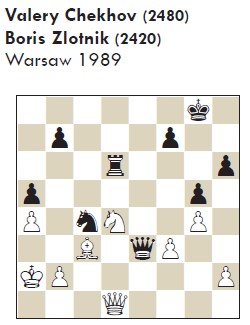 Black is clearly winning and Zlotnik decided to round off this well-played game with a decisive tactical sequence.
Black is clearly winning and Zlotnik decided to round off this well-played game with a decisive tactical sequence.
37...♘d2 38.♘f5 ♕e6+ 39.b3 ♖d3 40.♗xd2 ♕d7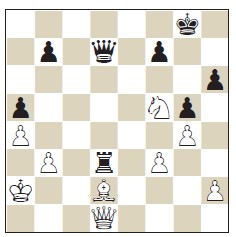 Black had some better moves along the way but this is the huge mistake allowing White a stunning riposte.
Black had some better moves along the way but this is the huge mistake allowing White a stunning riposte.
41.♕a1!!
Zlotnik relates: ‘It was only at this point that I realised that after capturing on d2, I am not going to have any good way to give check to the king on a3! In a state of shock I realised that I was bound to lose my three kingside pawns and probably the other two pawns as well. Therefore my first reaction was to resign the game. And to prevent myself from doing so, I leapt up from the board without even taking on d2 and I asked someone for a cigarette. And I began to reflect on several episodes in my life as a chess player, which, little by little, calmed me down. After this I returned to the board and my chess player’s routine went into action: calculation and evaluation. People who are in difficulties in general, and chess players in particular, enter this mental state where they frenetically look for a way out. And then suddenly a miracle took place: I was able to foresee the position which appeared in the game some 20 moves later, something which had never happened to me before and which has never happened since.’
41...♖xd2+ 42.♔a3 f6 43.♕xf6 ♖e2 44.♕g6+ ♔h8 45.♕xh6+ ♔g8 46.♕xg5+ ♔h8 47.♕h6+ ♔g8 48.♕g5+ ♔h8 49.♕f6+ ♔g8 50.♕g6+ ♔h8 51.♕f6+ ♔g8 52.h4 ♕c7 53.♘h6+ ♔h7 54.♕f7+ ♕xf7 55.♘xf7 ♔g7 56.♘d6 b6 57.♘c4 ♖f2 58.♘xb6 ♖xf3 59.♘c4 ♖f4 60.♘xa5 ♔f8
Zlotnik again: ‘It was precisely this position that I had seen so far in advance, without, of course, being able to evaluate it. At this point the game was finally adjourned and my opponent wrote down his sealed move. Overnight analysis at the time, and now confirmed by the latest engines, showed that White could not win.’
61.♘c4 ♖xg4 62.a5 ♔e8 63.♘b6 ♖g6 64.♔b4 ♔d8 65.♔c5 ♔c7 66.b4 ♖c6+ ½-½.
I read this book straight through during a couple of train trips and enjoyed it greatly. Just one word of warning: a couple of the blindfold puzzles are notated wrong, which caused me a fair bit of distress and soul-searching (‘Why am I so bad? Can’t I even find mate in 2?’). On page 49, Puzzle 3.2.2 should be White: ♔d3, ♕h3, ♖b3 and Black: ♔a6, ♖a7 and Pawn b7. On page 50, Puzzle 3.3.3, number 2 should be White: ♔f6 and Pawn h2, Black: ♔d3 and Pawn h3. That little caveat aside, I thoroughly recommend this book as a stimulating and thoughtful reflection on important aspects of chess. 4 stars!
***
Most of you probably know Anish Giri as a Twitter personality, but he is also a very strong player ☺. It is frankly amazing that one of the world’s top players creates an opening course like The Dragon Sicilian (Chessable) replete with new ideas and high-class insights. You compare this with my era as a young player, where opening secrets were closely guarded and opening recommendations by strong players were as likely to be wrong (perhaps even intentionally) as right and you feel lucky to be involved in chess right now! The Dragon Sicilian (Chessable) is another Chessable course to chess book crossover, and this approach continues to work beautifully. First of all the books are beautifully produced – in hardback, with coloured diagrams and a font that is a pleasure to read. And secondly, as I’ve noted before, moving from a video course to a chess book is the best way of avoiding a text dense with sub-variations. To be honest, I would have expected the Dragon to be an opening where you really did need those sub-variations, but Giri does a very nice job of keeping everything understandable without giving you the feeling that you’re missing out on essential knowledge.
The Dragon Sicilian (Chessable) is another Chessable course to chess book crossover, and this approach continues to work beautifully. First of all the books are beautifully produced – in hardback, with coloured diagrams and a font that is a pleasure to read. And secondly, as I’ve noted before, moving from a video course to a chess book is the best way of avoiding a text dense with sub-variations. To be honest, I would have expected the Dragon to be an opening where you really did need those sub-variations, but Giri does a very nice job of keeping everything understandable without giving you the feeling that you’re missing out on essential knowledge.
The book is actually much more than just the Dragon Sicilian, as Giri also provides complete repertoire options against all White’s attempts to avoid the Dragon, making this single book a very powerful complete repertoire against 1.e4. Perhaps the only thing that surprised me slightly there was the recommendation of this well-known ending against 5.f3 ...
1.e4 c5 2.♘f3 d6 3.d4 cxd4 4.♘xd4 ♘f6 5.f3 e5 6.♘b3 d5 7.♗g5 ♗e6 8.♗xf6 gxf6 9.exd5 ♕xd5 10.♕xd5 ♗xd5 11.♘c3 ♗e6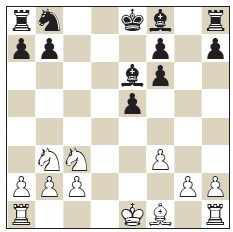 ... as I feel there is some potential to get this horribly wrong as Black at a lower level, but Giri makes a good case for it in his analysis.
... as I feel there is some potential to get this horribly wrong as Black at a lower level, but Giri makes a good case for it in his analysis.
The main lines Giri gives are extremely well-worked out and his main recommendation against the Yugoslav Attack is a surprising but really sensible way of avoiding a crazy kingside assault from White. I think this will come as a relief to any Black player after reading Giri’s introduction, which goes through the lines he didn’t recommend and why! The one thing that triggered me in the introduction was Giri’s comment about this crazy line:
1.e4 c5 2.♘f3 d6 3.d4 cxd4 4.♘xd4♘f6 5.♘c3 g6 6.♗e3 ♗g7 7.f3 0-0 8.♕d2 ♘c6 9.♗c4 ♗d7 10.0-0-0 ♖c8 11.♗b3 ♘e5 12.♔b1 Stronger than 12.h4 and causing Black a lot of difficulties as well, according to Giri. 12...♖e8 13.h4 h5 14.g4 hxg4 15.h5 ♘xh5 16.♗h6 ♔h7 17.♗xg7 ♔xg7 18.fxg4 ♗xg4 19.♘f5+ ♗xf5 20.exf5 ♖h8 21.fxg6 ♘xg6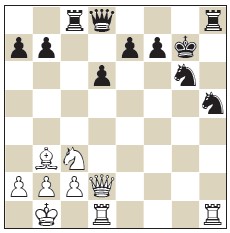 Giri says that modern engines no longer approve of this line – and indeed the initial evaluations are rather dodgy – but playouts of this position have led to a lot of draws.
Giri says that modern engines no longer approve of this line – and indeed the initial evaluations are rather dodgy – but playouts of this position have led to a lot of draws.
22.♘d5 22.♕d5 e6 23.♕d4+ ♕f6 24.♕xa7 ♘g3 25.♖xh8 ♖xh8 26.♕xb7 d5 27.a4 and now both 27...♕f4 and 27...♕e5 led to multiple draws between Leela and Stockfish.
22...♘f6 23.♖xh8 ♕xh8 24.♕g2 ♕d8 25.♘f4 ♕e8 26.♖g1 ♕c6 27.♘e6+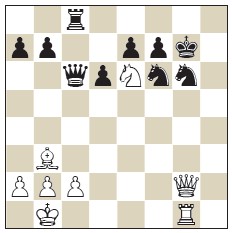 27...♔g8 28.♕g3 d5 29.♘f4 ♕d6 30.♕h3 ♖d8 31.♕h6 ♕b6 32.♖g5 ♕f2 33.a3 ♕e1+ 34.♔a2 ♕e4 35.c3 ♖d6 36.♘xg6 fxg6 37.♖xg6+ ♔f7 38.♖g1 ♔e8 39.♕h8+ ♔d7 and ½-½.
27...♔g8 28.♕g3 d5 29.♘f4 ♕d6 30.♕h3 ♖d8 31.♕h6 ♕b6 32.♖g5 ♕f2 33.a3 ♕e1+ 34.♔a2 ♕e4 35.c3 ♖d6 36.♘xg6 fxg6 37.♖xg6+ ♔f7 38.♖g1 ♔e8 39.♕h8+ ♔d7 and ½-½.
But you do have to concede the point: Giri’s recommendation in the book looks much better for Black than this! A really excellent book, produced by an elite player – can’t wish for more! 5 stars!
***
Finally, we round off this month’s reviews with Keep It Simple for Black by Christof Sielecki (Chessable). I suddenly realised that somehow I’d never reviewed any of Christof’s previous efforts in the Keep It Simple series so I’m belatedly making amends now!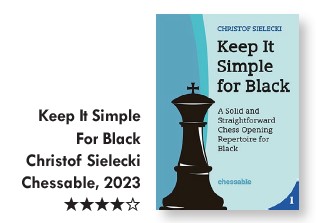 This is another Chessable hardback crossover, derived from a course that was voted the best opening course on Chessable in 2021.
This is another Chessable hardback crossover, derived from a course that was voted the best opening course on Chessable in 2021.
The basis of the course is the Caro-Kann against 1.e4 (with the trendy 1.e4 c6 2.d4 d5 3.♘c3 dxe4 4.♘xe4 ♘f6 line against the Classical and 1.e4 c6 2.d4 d5 3.e5 c5 against the Advance) and the Queen’s Gambit with 4...a6 (1.d4 d5 2.c4 e6 3.♘c3 ♘f6 4.♘f3 a6) against 1.d4, and the repertory is extended to all White’s first moves.
One of the nice things about playing the Queen’s Gambit Declined against 1.d4 is that you automatically have much of your Black repertoire covered against tricky 1.♘f3 or 1.c4 transposition attempts.
I was particularly interested by Sielecki’s recommendations in a line of the Queen’s Gambit Declined that was always thought to be clearly good for White in the pre-computer age.
1.d4 d5 2.c4 e6 3.♘c3 ♘f6 4.cxd5 exd5 5.♗g5 c6 6.e3 h6
A beginner’s mistake in the good old days, standard theory nowadays!
7.♗h4 ♗e7 8.♗d3 0-0 9.♘ge2 ♖e8 10.0-0 ♘bd7 11.f3
The Botvinnik setup. White aims for the e4-break.
11...b5 12.♗f2 a5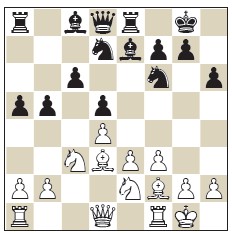 Once again, in the pre-computer age, I would have taken Black’s last two moves as a sign I was playing a weak player with no idea of strategy and looked for a central breakthrough to show my superior understanding! Nowadays, the engines just demonstrate that the central breakthroughs are a bit more fraught than you might think. Sielecki gives this line:
Once again, in the pre-computer age, I would have taken Black’s last two moves as a sign I was playing a weak player with no idea of strategy and looked for a central breakthrough to show my superior understanding! Nowadays, the engines just demonstrate that the central breakthroughs are a bit more fraught than you might think. Sielecki gives this line:
13.e4 dxe4 14.fxe4 ♘g4 15.h3 ♘xf2 16.♖xf2 ♘c5 17.dxc5 ♗xc5 with a very difficult position for White.
A very good course full of interesting and useful ideas. Somewhere between 4 and 5 stars I think – we’ll go for 4 stars this time!

